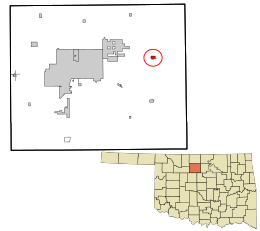Garber, Oklahoma facts for kids
Quick facts for kids
Garber, Oklahoma
|
|
|---|---|

Location in Garfield County and the state of Oklahoma.
|
|
| Country | United States |
| State | Oklahoma |
| County | Garfield |
| Area | |
| • Total | 0.50 sq mi (1.30 km2) |
| • Land | 0.50 sq mi (1.30 km2) |
| • Water | 0.00 sq mi (0.00 km2) |
| Elevation | 1,178 ft (359 m) |
| Population
(2010)
|
|
| • Total | 822 |
| • Estimate
(2019)
|
807 |
| • Density | 1,614.00/sq mi (622.76/km2) |
| Time zone | UTC-6 (Central (CST)) |
| • Summer (DST) | UTC-5 (CDT) |
| ZIP code |
73738
|
| Area code(s) | 580 |
| FIPS code | 40-28500 |
| GNIS feature ID | 1093108 |
Garber is a city in Garfield County, Oklahoma, United States. The population was 822 at the 2010 census. The city is named after Martin Garber, father of Milton C. Garber, former U.S. congressman, Enid mayor, newspaper editor, and judge. The land was previously part of the Cherokee Outlet, until the U.S. government declared it open to non-Indian settlement in 1893.
Contents
History
The Garber family participated in the Land Run of 1893, claiming 160 acres (0.65 km2) of land that would become the city of Garber. The Enid & Tonkawa Railway built a line in 1899 that ran from North Enid to Billings, near the brothers' land. In October 1899, the Garber Town Company, owned by brothers Milton C. and Burton A. Garber, platted the town. Burton Garber was part-owner of the Garber Oil Company.
Geography
Garber is located in eastern Garfield County, 19 miles (31 km) east of Enid, the county seat. Oklahoma State Highways 15 and 74 pass together through the west side of the city, with Highway 74 leading north 18 miles (29 km) to Lamont and south 9 miles (14 km) to Covington. Highway 15 leads south and west to Enid, and north and east 15 miles (24 km) to Billings.
According to the United States Census Bureau, Garber has a total area of 0.50 square miles (1.3 km2), all of it land.
Demographics
| Historical population | |||
|---|---|---|---|
| Census | Pop. | %± | |
| 1910 | 382 | — | |
| 1920 | 1,446 | 278.5% | |
| 1930 | 1,356 | −6.2% | |
| 1940 | 1,086 | −19.9% | |
| 1950 | 957 | −11.9% | |
| 1960 | 905 | −5.4% | |
| 1970 | 1,101 | 21.7% | |
| 1980 | 992 | −9.9% | |
| 1990 | 959 | −3.3% | |
| 2000 | 845 | −11.9% | |
| 2010 | 822 | −2.7% | |
| 2019 (est.) | 807 | −1.8% | |
As of the census of 2000, there were 845 people, 360 households, and 244 families residing in the city. The population density was 1,721.2 people per square mile (665.8/km2). There were 447 housing units at an average density of 910.5 per square mile (352.2/km2). The racial makeup of the city was 94.32% White, 0.24% African American, 3.20% Native American, 0.12% Asian, 0.12% from other races, and 2.01% from two or more races. Hispanic or Latino of any race were 0.24% of the population.
There were 360 households, out of which 28.3% had children under the age of 18 living with them, 53.1% were married couples living together, 10.8% had a female householder with no husband present, and 32.2% were non-families. 31.1% of all households were made up of individuals, and 16.7% had someone living alone who was 65 years of age or older. The average household size was 2.35 and the average family size was 2.93.
In the city, the population was spread out, with 25.8% under the age of 18, 7.8% from 18 to 24, 23.7% from 25 to 44, 23.2% from 45 to 64, and 19.5% who were 65 years of age or older. The median age was 39 years. For every 100 females, there were 92.5 males. For every 100 females age 18 and over, there were 88.9 males.
The median income for a household in the city was $25,000, and the median income for a family was $32,778. Males had a median income of $27,417 versus $18,750 for females. The per capita income for the city was $13,284. About 8.5% of families and 12.4% of the population were below the poverty line, including 19.5% of those under age 18 and 13.5% of those age 65 or over.
Economy
Agriculture, oil, and cattle are Garber's primary industries. Petroleum drilling began as early as 1904-05. The Garber Oil and Gas Company (partly owned by Burton A. Garber) installed Garber's first gas well in 1905. The Garber Field was opened in 1916 when the Hoy well came in at two hundred barrels per day. Peak production came in November 1925, and by 1940 a well in Section 18, T22N, R3W still held a state record for initial production, 27,000 barrels per day (4,300 m3/d). Booms happened again in 1925 and 1927, continuing through the 1930s. Three refineries operated by 1929. By 1920 the boom had grown Garber to an unofficial population count of 2,200 (the U.S. Census registered 1,446).
See also
 In Spanish: Garber (Oklahoma) para niños
In Spanish: Garber (Oklahoma) para niños



